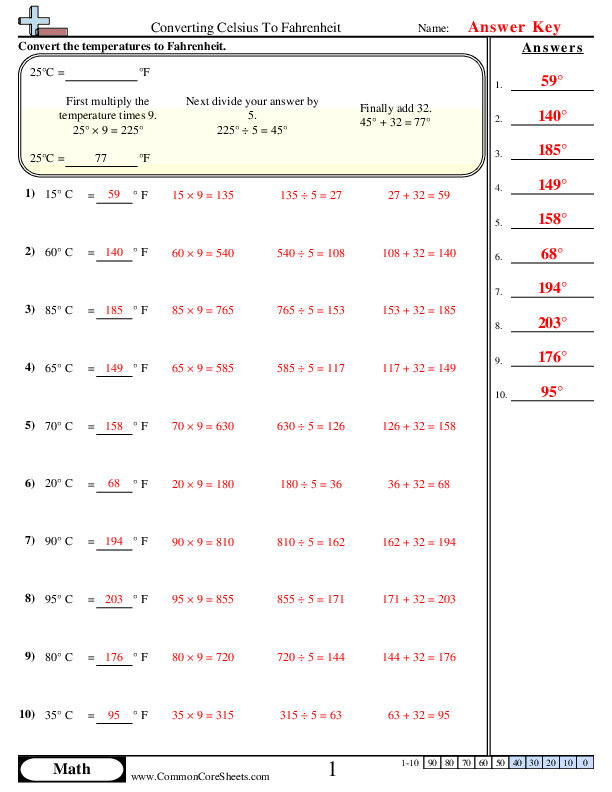Looking for the best temperature worksheets on the internet? Look no further! Our temperature worksheets are perfect for helping students learn about temperatures, thermometers and converting Fahrenheit. With our free temperature worksheets, you can be sure that your students gain a full understanding of temperature concepts before they move onto more difficult topics. Our worksheets feature images and diagrams of thermometers to help students visualize the concept of temperature while they practice using a variety of formulas. We also include detailed explanations and clear examples of how to use formulas in converting Fahrenheit to Celsius. We're sure our temperature worksheets will make learning about this topic easy for your students!
Browse Sheets By Problem Type
×

Celsius to Fahrenheit


×
Description:
"This worksheet is designed to aid children in mastering the concept of converting Celsius to Fahrenheit, explained step by step in ten math problems. Its customizable content can be adapted for different learning styles, converted into flash cards for efficient review, or integrated into distance learning curriculums, making complex math subjects kid-friendly and easier to grasp."

×
Student Goals:
Understanding of Temperature ConversionAfter successfully completing this worksheet, students should have a solid understanding of how to convert temperatures from Celsius to Fahrenheit. Grasping this conversion is a fundamental aspect within the field of mathematics, science and daily life, enhancing their ability to understand weather forecasts, bake recipes that require specific oven temperatures, or use any application that centers on these temperature metrics.Problem Solving SkillsThe worksheet boosts the problem-solving skills of the student. It privileges them with the skills to dissect a problem, identify the procedure to solve it, and then execute the plan. It will facilitate their inherent ability to analyze and breakdown complex problems into manageable bits, an essential skill in tackling both math and real-life challenges.Application of Mathematical OperationsThis exercise affirms the student's understanding of the basic mathematical operations; multiplication, division, and addition. It provides an example of how these operations are used daily beyond the classroom walls, strengthening their comprehension and application.Cognitive AbilitiesThe worksheet helps improve cognitive abilities in students. Implementing number manipulation, calculation execution, and logical reasoning enhances their brain function, attentiveness, and memory. This improvement will be reflected in other areas of learning and information processing.Enhancement of Practical Math SkillsUpon completion of this worksheet, pupils will enhance their practical math skills. The understanding of temperature conversion is applicable in many real-world scenarios and disciplines like physical sciences, engineering, and even in culinary arts. This cements their real-world application of theoretical mathematical concepts.Building ConfidenceSuccessfully doing conversions and understanding the supporting math instills confidence in students. This confidence will encourage them to take on more challenging problems and equations, not only in temperature conversions but in other mathematical areas as well. This development is crucial in their academic growth and future mathematical endeavors.



Fahrenheit to Celsius


×
Description:
"This worksheet is designed to enhance children's mathematical abilities in the specific area of temperature conversion from Fahrenheit to Celsius. It presents ten robust examples, detailing step-by-step computation from Fahrenheit to Celsius which is an essential concept in elementary math. This customizable tool can also be transformed into flashcards, or utilized for distance learning, broadening its applicability while maintaining its educational efficacy."

×
Student Goals:
Understanding Temperature ConversionUpon completing this worksheet, students should now have a clear understanding of how to convert temperatures from Fahrenheit to Celsius. They will comprehend how to successfully navigate the formula used in this conversion which includes subtracting 32 from the Fahrenheit temperature, multiplying the result by 5, and finally dividing by 9. This foundational skill is a key component of various scientific concepts and processes, extending their mathematical aptitude.Enhanced Problem Solving AbilitiesThrough the practical application of solving conversion problems, students will have boosted their problem-solving skills. They will have gained proficiency in breaking down complex problems into simple, manageable steps which is beneficial across all topics in mathematics and science. This worksheet enables them to practice and hone in on their analytical capacity, laying the groundwork for solving more intricate problems in the future.Improved Numerical ProficiencyMastering the conversion method taught in this worksheet requires fundamental operations like subtraction, multiplication, and division. Therefore, students should see a notable improvement in their numerical skills. They can manipulate and interpret numerical information with more comfort and fluency. This strengthens their overall mathematical competence, a vital skill that will be useful throughout their academic journey and beyond.Thorough Grasp of Mathematical FormulasAny observable growth in comprehending and applying mathematical formulas is another significant achievement after this worksheet exercise. Students will understand how a formula encapsulates a consistent method for solving a specific type of problem. This comfort with using formulas will support students in efficiently tackling similar problems. It transcends beyond temperature conversions, equipping them with the much-needed confidence to handle equations, expressions, and formulas across the mathematical field.Expanded Scientific KnowledgeLastly, the ability to convert temperatures between Fahrenheit and Celsius scales broadens students' understanding of scientific measurements. They will understand that different regions of the world use different temperature scales and why these conversions are crucial in universal scientific communications. It takes them one step closer to becoming global citizens by appreciating different measurement systems used worldwide.



